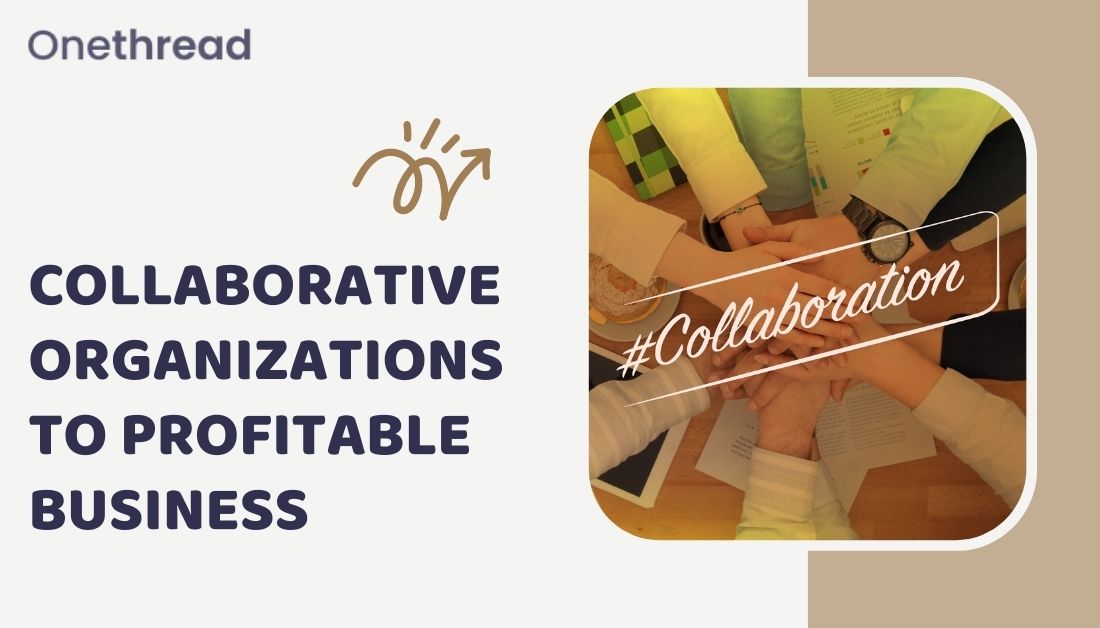Do you want to take your business to the next level of success? Do you wish your organization could become more profitable and efficient? One of the best ways to do this is by engaging in collaborative organizations. Collaborative organizations are structures where two or more businesses work together to achieve their collective goals.
This type of collaboration can be incredibly beneficial for both parties as it allows them to share resources, expertise, and customers while also getting access to new markets and potential strategic partners.
So, what do you need to know about collaborative organizations, and how can they help your business reach its full potential? Don’t worry!
I am here to discuss all the benefits of collaborative organizations and how they can help to make your business more profitable. Also, I will explain how you can start with collaborative organizations and the steps you need to take to ensure success.
By understanding the advantages of collaboration, you can better decide which type of organization best suits your business needs. So, don’t waste any more time and let’s get started!
Why is collaboration important in the workplace?
Collaboration encourages employees to share their ideas, knowledge, and resources. It enables organizations to leverage the collective expertise of their team members and enhance productivity.
When teams work together, they can better brainstorm solutions and develop innovative strategies. Here are some of the other benefits of collaboration:
- Increased Innovation and Creativity: Collaboration encourages employees to think outside the box and develop innovative solutions for complex problems.
- Enhanced Productivity: Working together as a team can help employees focus on their tasks and achieve results faster.
- Improved Decision-Making: When teams work together, they can identify potential issues and risks more quickly and accurately. It enables them to make better decisions.
- Enhanced Efficiency and Cost Savings: By leveraging their team members’ collective knowledge and expertise, organizations can get more done in less time. It can lead to improved efficiency and cost savings.
- Improved Employee Engagement: Collaborative organizations create an environment of support and trust, which can help to boost employee morale and engagement.
How do Collaborative Organizations Work?

Collaborative organizations thrive on open communication, shared goals, and a vibrant culture of collaboration that propels them forward. But that’s just the beginning.
To create an effective collaborative organization, teams must work together effectively. Also, organizations should create feedback mechanisms for teams to solicit input from each other.
Here are some other key components of successful collaborative organizations:
Clear roles and Responsibilities
Each team member must know their role and responsibilities in collaborative organizations. It helps to ensure that tasks are completed on time and that the team works together towards a common goal.
It also helps to ensure everyone is held accountable for their actions, which can help boost morale and motivation. Furthermore, clear roles and responsibilities ensure everyone knows what they must focus on.
Collaboration helps maintain clarity and focus, making it easier for teams to progress on their tasks.
Distributed Decision Making
Collaborative organizations also emphasize the importance of distributed decision-making. The entire team makes the decisions collaboratively rather than one or two people.
Collaboration encourages teams to think critically and develop better solutions for complex problems. Also, it ensures that everyone has input on a particular decision that might otherwise be overlooked.
Organizations can reach the best possible solution by distributing decision-making among team members.
Shared Resources and Expertise
In collaborative organizations, teams are encouraged to share their resources and expertise with each other. It helps to ensure that everyone is on the same page and can leverage each other’s strengths.
Additionally, it encourages team members to learn from one another and develop new skills. Sharing resources and expertise can benefit everyone when organizations provide access to shared resources.
10 Habits of Highly Collaborative Organizations
When you foster collaboration in an organization, certain habits can help teams succeed. Here are some of the key habits of highly successful collaborative organizations:
Communicate Clearly




Do you want to ensure success in your collaborative organization? Communication is key. Imagine a team without any communication. It won’t be able to work together towards its goals.
That’s why teams need to communicate clearly and effectively. When your team can communicate effectively, it will be more productive and successful.
In a team, everyone should understand each other’s ideas and opinions. That way, teams can come up with better solutions faster. Furthermore, clear communication builds trust among team members and encourages them to work together more effectively.
But how do you foster clear communication in your organization? One way is to use the right communication tools. Use the Onthread platform to manage your team conversations and collaborate more efficiently.
Onthread helps teams have clear, structured, and organized conversations. It also lets you quickly share files with other organization members and easily track tasks in real-time. So, why not try Onthread today and experience the power of collaboration?
Encourage Diversity




Another important habit of successful collaborative organizations is to encourage diversity. Imagine a team without any diversity. It won’t be able to tap into its members’ different perspectives and skills.
In this case, the team will benefit from valuable insights and ideas. That’s why teams need to embrace diversity.
A team of members of different genders, ages, races, cultures, and backgrounds can open up new doors for innovation and creativity. Furthermore, when you encourage diverse perspectives within your organization, you create an open environment that encourages collaboration.
Is there any way to encourage diversity in your organization? Yes! You can start by creating a diverse team and giving everyone equal opportunities for growth and development. Also, you can offer flexible working arrangements that make it easier for everyone to work from anywhere.
When you provide training and development opportunities to all your team members regardless of their background, you create a level playing field for everyone. It will help to foster collaboration and promote inclusivity within your organization.
Work with the flow




Your organization is doing great, and then suddenly, its productivity decreases. What could be the reason? It might be because your team members are not working with the flow. Collaborative organizations should work with the flow of ideas rather than trying to control them. When teams are encouraged to share their ideas and opinions, it helps create a more productive environment.
Additionally, collaborative organizations should be open to changes and new ideas. It helps keep things interesting and encourages team members to think outside the box.
Working with the flow also ensures everyone is on the same page and understands each other’s organizational roles. But how do you create an environment that encourages working with the flow?
You can use the Onthread platform for teams to work in sync. It helps ensure everyone is on the same page and working towards a common goal.
Also, Onthread’s features, such as task management, file sharing, and real-time updates, help teams stay organized and communicate efficiently. So, why not experience the power of collaboration with Onthread!
Encourage Experimentation
Highly collaborative organizations encourage their team members to experiment and take risks. It helps foster creativity and innovation within the organization, allowing teams to develop more unique solutions for complex problems.
When teams are free to experiment, they can also learn from their mistakes and develop new skills. Additionally, it helps to create an environment of trust where team members feel supported in their endeavors.
By encouraging experimentation, you let your teammates know that it is okay to make mistakes and can ensure everyone is motivated and engaged with their work.
Foster Continuous Learning
Organizations that promote collaboration should also foster a culture of continuous learning. Creating opportunities for team members to learn new skills and develop their knowledge base.
Moreover, organizations can provide access to books, articles, or online courses to keep everyone up-to-date on the latest developments. Organizations need to foster continuous learning to ensure success with Onethread project management tools and resources.
Utilize Technology




Technology can be a potent tool when it comes to fostering collaboration. Onethread is a project management tool that helps teams stay organized and on track by providing easy access to information.
Technology can also help teams communicate more effectively by providing real-time communication channels. By utilizing the latest technologies available, organizations can ensure collaborative efforts remain efficient and effective.
Prioritize Teamwork




Collaborative organizations should always prioritize teamwork. It means creating a culture where everyone is encouraged to work together and share their expertise with one another.
Additionally, teams should be allowed to challenge each other and develop better solutions for complex problems. When teams are free to work together, they can create a culture of innovation and collaboration that benefits everyone.
Recognize Achievements
Organizations should recognize the achievements of their team members as this helps to create an environment of appreciation and respect. By recognizing the contributions of individual team members, organizations can ensure that everyone feels valued and appreciated for their hard work.
You motivate your team to continue working hard and collaborating effectively when you recognize their achievements.
Celebrate Success
Highly collaborative organizations also make sure to celebrate their successes. In this way, teams are motivated to achieve great things and a culture of celebration is created. It can also motivate and engage team members by giving them a sense of accomplishment.
You can celebrate success in many ways, such as awards, team outings, or even a simple thank you. It will ensure that everyone feels appreciated and encouraged to continue collaborating.
Review Progress
Successful collaborative organizations make sure to review their progress regularly. It helps teams assess their current situation and determine which areas need improvement.
When organizations review progress, they can ensure they are on track to achieving their goals and identify potential problems before they become major problems. If teams can review their progress regularly, they will be better prepared to handle any obstacles that may arise.
Are there any tools that help Collaborative Organizations?
Yes, there are a variety of tools that can help collaborative organizations to stay organized and on track. Teams can keep track of tasks and deadlines with tools such as Onethread project management software. By using this software, teams can easily access and update project information so that everyone is working together. Here are some benefits of using these tools:
- Increased efficiency and productivity
Onethread allows teams to quickly access the necessary information without wasting time searching for it. This improved efficiency helps teams stay on track and complete tasks more quickly. These tools can also help reduce delays or disruptions that may occur when trying to coordinate between different team members.
- Improved communication
This project management tool makes it easier for team members to communicate their ideas or concerns on time. It helps everyone stay up-to-date and ensures no one is left out of the loop. These tools also allow for real-time conversations, which can help ensure everyone is on the same page.
- Enhanced collaboration
By using tools such as Onethread and Slack, team members can collaborate more effectively with one another. It helps teams to brainstorm ideas or solve problems more efficiently. These tools also provide an easy way for everyone to access shared documents and resources, which can speed up tasks.
- Improved decision-making
By utilizing these project management tools, organizations can make better decisions faster. Teamwork allows different elements to be reviewed and discussed quickly, improving problem-solving efficiency. It helps teams save time and get tasks done on time.
- Increase visibility
By using tools such as Onethread and Slack, organizations can increase team members’ visibility into their projects. It helps ensure that everyone is informed of project progress and allows for more accurate planning. Additionally, teams can access data quickly, which helps them better understand the current status of their projects.
Conclusion
Collaboration organizations are essential for successful businesses in the modern world. Teams will work more effectively together if they foster a culture of trust, encourage experimentation, foster continuous learning, use technology, and prioritize teamwork. You promote motivation and engagement by recognizing and celebrating your team member’s accomplishments. Remind your team members that collaboration is key to success!
